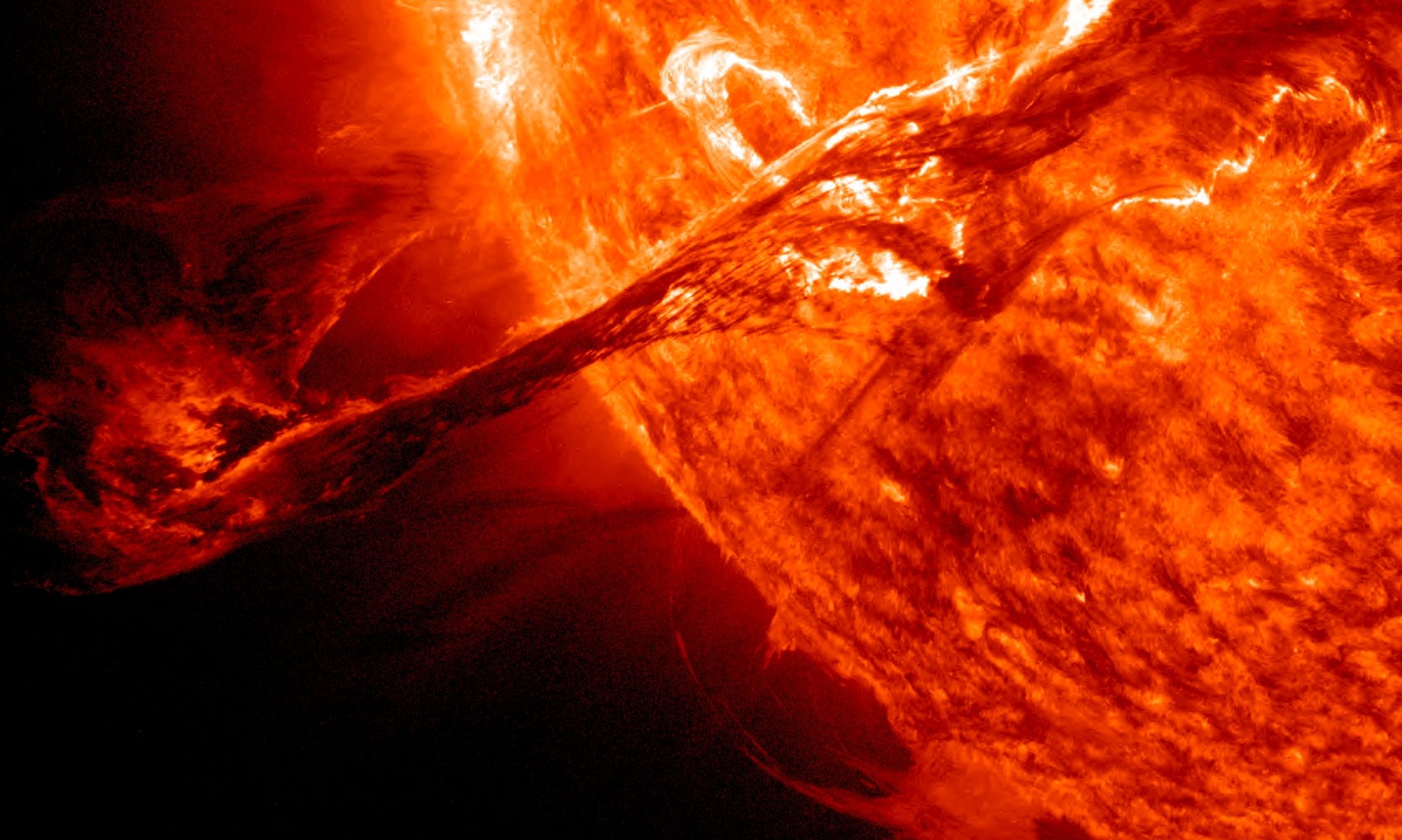This page is under construction and will be updated soon, some links may be broken while we get all of our information moved over.
AFOSR Project description:
The most hazardous forms of space weather disruption for communication and human space satellites are the bursts of solar energetic particles (SEPs) associated with the eruption of fast coronal mass ejections (CMEs)/ eruptive flares. These particles are ejected in the two directions: 1) downward into the solar atmosphere to produce hard and soft X-ray, EUV and UV emission in flaring events and 2) upward in the interplanetary space as solar energetic particles associated with eruptive flares. The ejection scenario and parameters of these energetic particles are of a great interest for many researchers and space industry as they define space weather in the heliosphere. In addition, SEPs jointly the fast solar wind particles can be accelerated further during their passage through various current sheets occurring in the heliosphere: the heliospheric current sheet (HCS) or front current sheets of the interplanetary coronal mass ejections (ICMEs). These energetic particles reveal very peculiar distributions in velocities and pitch angles not anticipated by regular models of stochastic particle acceleration by turbulence or shocks. This requires a revision of the existing particle acceleration models with the emphasis on their links to magnetic reconnection processes occurring in the Sun and heliosphere. The proposed project will deal with the investigation of particle parameters (energy, directivity, pitch angle distribution) during their passage through reconnecting current sheets occurring in the solar corona (eruptive flares) and in the heliosphere. The investigation of particle acceleration will be carried out with a 3D PIC approach combined with a 3D test particle approach. Their consequent transport effects in the heliosphere and solar atmosphere studied with Fokker-Planck and local helioseismology approaches with the codes developed by PI and co-PI in the previous project. This will help one to understand the fundamental properties of accelerated particles in reconnecting current sheets and, consequently, to predict the parameters of energetic particles (energy/velocity and pitch angle distributions as well as particle density profiles) passing through the current sheets with low (heliosphere) and high (solar corona) density plasmas and for different types of magnetic field topologies, or scenarios of magnetic reconnection. The predicted parameters of accelerated particles will be probed by the observations of eruptive flares in the Sun with and without sunquakes and associated with them SEP events as well as by the heliospheric observations of the sector boundary crossings (for HCS) and their passage through ICMEs.
Location: Department of Mathematics, Physics and Electrical Engineering, Faculty of Engineering and Environment, University of Northumbria, UK
Financial support: This project was supported by the US Airforce, grant 16IOE055 (2017-2020)
EPSRC Project Description:
A sophisticated model of flaring atmosphere heated by a proton and electron beam injected from the primary energy release site on the top is investigated. Protons and electrons are considered to be accelerated by electric field in the reconnecting current sheet and then are assumed to precipitate into a converging magnetic loop down to the bottom of the atmosphere in Coulomb and inelastic collisions with the ambient plasma and beam ions and electrons while protons also exchange their energy with the ambient plasma electrons via the kinetic Alfven wave turbulence. A possible separation of electrons from protons in the beam during the precipitation caused by a wide-angular electron scattering is to be taken into account by solving the kinetic and integral Ohmic law equations. Further precipitation of both beams to the bottom of the atmosphere is also investigated as well as their energy deposition at given depth and its timescale, the outcome is to be compared with helioseismic observations. A temporal evolution of the resulting hard X-ray bremsstrahlung and soft X-ray line emission (Ca XIX, Si XV, Fe XXV) from flaring atmospheres is to be compared with those produced by pure electron beams and the observed ones.
Location: Department of Computing and Mathematics, School of Informatics, University of Bradford, UK.
Financial support: This project was supported by the Engineering and Physical Sciences Research Council, grant GR/R/53449/01 (2002-2005)
PPARC/STFC Project Description:
The project aims to investigate proton and electron kinetics at acceleration by varying electric field, generated during magnetic reconnection in a reconnecting current sheet (RCS), formed by interacting loops, and at their precipitation into the loop legs. The particle trajectories and their distributions in an RCS governed by the electric field will be investigated using test particle, particle-in-cell and full kinetic approaches for various magnitudes of the magnetic field components of a 3D magnetic configuration taking into account the collective electric field effects. The precipitation of electron and proton beams into flaring atmospheres with a converging magnetic field will be further investigated including interaction with particles (for electrons) and with particles and waves (for protons). The plasma heating and macro-velocities of flaring atmospheres caused by hydrodynamic responses to the injection of each type of particles will be compared with the helioseismic observations and suitable scenarios for particle transport will be selected.
Location: Department of Computing and Mathematics, School of Informatics, University of Bradford,.
Financial support: This project is supported by the Particle Physics and Astronomy Research Council (PPARC), now Science and Technology Facilities Council (STFC), grant duration: 24 months (October 07 – September 09).
See vacancies for current job opportunities.
